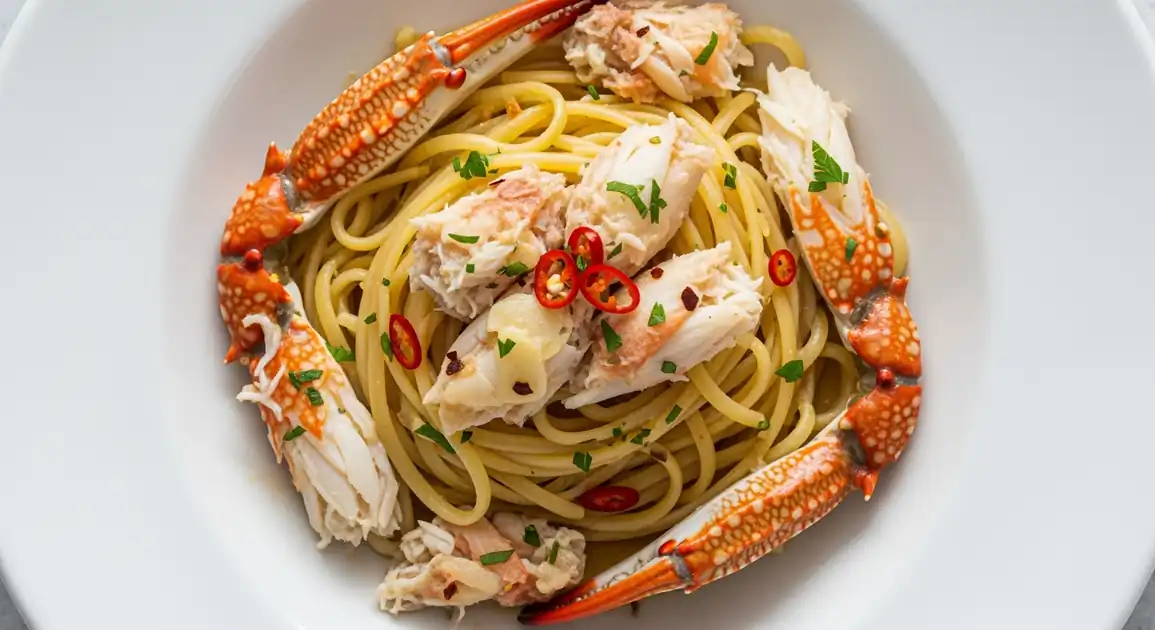Blue Swimmer Crab Linguine
Blue Swimmer Crab Linguine

Description
Melbourne's cosmopolitan food scene embraces Blue Swimmer Crab Linguine as a sophisticated offering that brings together the city's Italian heritage with premium Australian seafood. Found primarily in upscale restaurants, Italian eateries, and seafood specialists, the dish reflects Melbourne's reputation for culinary excellence and multicultural influences.
Dietary Information
Serving information
Serving style
Elegantly presented in wide, shallow bowls. Melbourne chefs often add artistic touches like micro herbs, edible flowers, or precisely placed drizzles of extra virgin olive oil. Portion sizes tend toward the moderate, emphasizing quality over quantity.
Quick facts
Lunch: 12 PM - 3 PM (extended to 4 PM on weekends). Dinner: 6 PM - 10 PM (earlier start at 5:30 PM and later close at 11 PM on Fridays and Saturdays).
Safety Tips
What to Look For
-
Crab meat appears white and opaque
Properly cooked crab meat should be completely white or very slightly pinkish, never translucent or gray. Undercooked crab poses significant food safety risks.
-
Pasta is served steaming hot
Seafood dishes should be served at proper temperatures to prevent bacterial growth. A steaming plate indicates the dish has been freshly prepared and held at safe temperatures.
-
Clean, oceanic aroma without fishiness
Fresh crab has a sweet, oceanic smell. Any strong fishy or ammonia-like odors indicate the crab may not be fresh or has been improperly stored.
-
Visible chunks of crab meat throughout the dish
Quality versions of this dish showcase identifiable pieces of crab meat rather than tiny shreds or paste-like textures that might indicate lower quality or substitute products.
What to avoid
-
Strong fishy or ammonia smell
These odors indicate the crab is not fresh and could pose health risks. Fresh seafood should never smell strongly 'fishy' or like ammonia.
-
Gray or yellowish crab meat
Discolored crab meat may indicate spoilage or improper cooking. Properly cooked blue swimmer crab meat should be predominantly white.
-
Shell fragments mixed in with the pasta
Beyond being unpleasant to eat, shell fragments suggest hasty or careless preparation, which might indicate other corners being cut in the kitchen, including with food safety practices.
-
Pre-plated dishes sitting under heat lamps
Seafood pasta dishes should be made to order. Dishes kept warm for extended periods can develop food safety issues and significantly diminish in quality.
Price information
Price range
Budget tips
- Some restaurants offer early bird specials (before 6:30 PM) with reduced prices.
- Lunch service typically offers the same dish at 15-20% less than dinner prices.
- Italian restaurants in suburbs like Brunswick or Carlton may offer better value than CBD venues.
- Check restaurant social media for occasional promotions or seafood-focused special events.
Value indicators
- Generous, visible pieces of hand-picked crab meat.
- House-made pasta (mentioned on the menu).
- References to specific sourcing (Victorian or South Australian waters).
- Appropriate portion size that doesn't rely on excessive pasta to compensate for minimal crab.
- Listed as a signature dish or chef's specialty.
Where to Find This Dish
Carlton/Lygon Street
Melbourne's historic Italian precinct features several restaurants offering authentic versions of this dish with an Italian influence.
Lygon Street, Argyle Square, Cinema Nova precinct
Dinner, Weekend Lunch
Southbank/South Wharf
Upscale waterfront restaurants along the Yarra River often feature premium seafood pasta dishes.
Crown Complex, South Wharf Promenade, Southgate Complex
Dinner, Weekend Lunch
St Kilda/Port Melbourne
Beachside dining areas where seafood restaurants offer views along with their crab linguine.
St Kilda Pier, Station Pier, Acland Street
Lunch, Sunset Dinner
CBD Fine Dining
High-end restaurants in Melbourne's central business district often feature sophisticated versions of this dish.
Flinders Lane, Collins Street, Hardware Lane
Dinner, Business Lunch
Vendor Tips
- Ask if the crab is sourced from Victorian waters or specific regions like South Australia's Spencer Gulf.
- Check if the restaurant makes their pasta fresh in-house.
- Look for chef-owned establishments, which often take more care with seafood sourcing and preparation.
- Restaurants that specify the source of their seafood on the menu typically have better quality control.
How to Order
Regional Variations
-
Italian-Melbourne Style
(Carlton Style)
Versions found in Melbourne's Italian district often have a stronger Mediterranean influence, sometimes with the addition of cherry tomatoes, capers, or a touch of anchovy for umami depth.
-
Modern Melbourne
(Contemporary Australian)
Higher-end restaurants might incorporate native Australian ingredients like sea herbs, finger lime, or lemon myrtle alongside the traditional components.
-
Asian-Influenced Crab Linguine
(Fusion Style)
Reflecting Melbourne's multicultural dining scene, some venues offer versions with subtle Asian influences such as ginger, lemongrass, or a dash of fish sauce for complexity.
-
Market-Fresh Version
(South Melbourne Market Style)
Restaurants near Melbourne's famous markets often feature simpler preparations that emphasize the freshness of ingredients sourced that morning, with minimal sauce or additional flavors.
Cultural context
History
This dish reflects Australia's evolving food culture and the significant Italian immigration influence on Australian cuisine. Blue swimmer crabs have been harvested in Australian waters for generations, but their incorporation into pasta dishes gained popularity during the 1980s and 1990s as Australia developed its own distinctive fusion cuisine. In Melbourne specifically, the strong Italian community's culinary traditions merged with access to superb local seafood to create dishes like this. Today, it represents high-end Australian seafood cuisine that honors both Mediterranean techniques and local ingredients.
Local significance
The dish represents Melbourne's sophisticated fusion of its strong Italian culinary heritage with premium Australian seafood. It embodies the city's reputation for excellent dining and multicultural influences.
Eating customs
- In Melbourne's dining scene, it's customary to share the experience of the dish with table companions, discussing the flavor and preparation.
- Perfectly acceptable to request additional bread to mop up the sauce - good restaurants will offer this automatically.
- Many Melbourne diners will inquire about the source of the crab and the preparation method - this is welcomed by quality establishments.